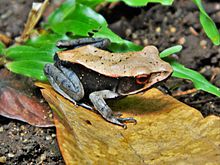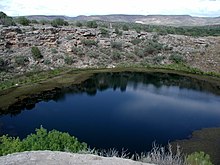


Endemism is the state of a species being found only in a single defined geographic location, such as an island, state, nation, country or other defined zone; organisms that are indigenous to a place are not endemic to it if they are also found elsewhere.[1] For example, the Cape sugarbird is found exclusively in southwestern South Africa and is therefore said to be endemic to that particular part of the world.[2] An endemic species can also be referred to as an endemism or, in scientific literature, as an endemite.[citation needed] Similarly many species found in the Western ghats of India are examples of endemism.
Endemism is an important concept in conservation biology for measuring biodiversity in a particular place and evaluating the risk of extinction for species. Endemism is also of interest in evolutionary biology, because it provides clues about how changes in the environment cause species to undergo range shifts (potentially expanding their range into a larger area, or becoming extirpated from an area they once lived), go extinct, or diversify into more species.[3]
The extreme opposite of an endemic species is one with a cosmopolitan distribution, having a global or widespread range.[1]
A rare alternative term for a species that is endemic is "precinctive", which applies to species (and other taxonomic levels) that are restricted to a defined geographical area.[4] Other terms that sometimes are used interchangeably, but less often, include autochthonal, autochthonic, and indigenous; however, these terms do not reflect the status of a species that specifically belongs only to a determined place.
- ^ a b Morrone, Juan J. (2008). "Endemism". Encyclopedia of Ecology. Vol. 3 (2 ed.). Elsevier. pp. 81–86. doi:10.1016/B978-0-444-63768-0.00786-1. ISBN 978-0-444-64130-4.
- ^ Riley, Adam (13 December 2011). "South Africa's endemic birds". 10,000 Birds. Adam Riley. Archived from the original on 27 November 2020. Retrieved 9 December 2020.
- ^ Qian, Hong; Mishler, Brent; Zhang, Jian; Qian, Shenhua (2024). "Global patterns and ecological drivers of taxonomic and phylogenetic endemism in angiosperm genera". Plant Diversity. 46 (2): 149–157. Bibcode:2024PlDiv..46..149Q. doi:10.1016/j.pld.2023.11.004. PMC 11128859. PMID 38807907.
- ^ "Precinctive". Encyclopedia of Entomology. Dordrecht: Springer. 2004. pp. 1819–1821. doi:10.1007/0-306-48380-7_3391. ISBN 978-0-306-48380-6.